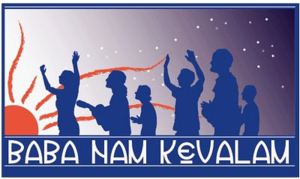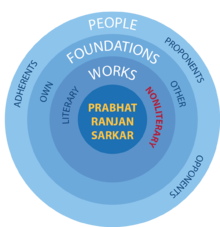User:Abhidevananda/Sandbox8
 | This is Abhidevananda's sandbox for new articles. It serves as a testing spot and page development space. This is not an encyclopedia article. |
| Kiirtan | |
|---|---|
 | |
| Founder(s) | Shrii Shrii Anandamurti |
| Type | Spiritual practice |
| Region served | Worldwide |
| Location in Sarkarverse | |
Kiirtan (or kiirtana} is the chanting out loud of a specially empowered mantra, an 8-syllabled siddha mantra (perfect incantation). In Ananda Marga, the mantra used is Bábá nám kevalam.
History
Tradition
Practice
Benefits
Perfect kiirtan
In 1982 (exact date unknown), Shrii Shrii Anandamurti gave a discourse in which were set out the requirements for a perfect kiirtan. Many other topics were also addressed, for example the appropriate ideation to be taken while practicing kiirtan and why a siddha mantra must have eight syllables. This discourse was distributed in the form of cyclostyled sheets under the title of "Bio-psycho-spiritual System of Kiirtan". Ac. Abhidevananda Avadhuta kept secure his copy of that discourse. In the mid-1990s he submitted his copy to the Central Publications Department, which had put out a request for any lost discourses. However, this discourse was not published until 2002. And in 2002, it was published in a mangled form (minus the explanatory Samskrta and with misleading rather than constructive footnotes). Below is the complete discourse in its original form and with useful footnotes.
Bio-psycho-spiritual System of Kiirtan
- An action may be treated as 'finality' if it satisfies the following conditions: 1. it has been fully complied with 2. the result of the compliance is in hand. This type of completion is known as upavasya.[nb 1] We repeat siddha mantra (Bábá Nám Kevalam) in different tunes. What is the upavasya of it? Let us take an example. I cross the threshold and as a result of it I enter the room. The utterance (internal or external) of the first syllable of a mantra is like crossing the threshold and entering a new world. The proper accomplishment of work after entering the new world culminates into a result which gives a feeling of bliss and perfection. This feeling is an embodiment of pleasure.
- In day-to-day life, we first inhale and then exhale. The mantra is repeated according to the syllabic rhythm of inhalation and exhalation. This act of breathing in the mundane sphere has no end in individual life. Breathing is an action and so a living being is always engaged in some sort of action. This constant effort is known as Yatamana. This is the first stage of progress. In the second stage, he wants to rise high with the firm determination to achieve his goal. And while doing so he is in a position to have control over some or other of his mental propensities for some time, but has no control on the other propensities at all. This stage is known as Vyatireka. In this stage he achieves concentration for some time and then again loses it. Then comes Ekendriya, which is the third stage of progress in sadhana. This is the stage when he has control over a particular mental propensity, and that control is more lasting. Due to constant repetition the mantra is sounding at his ear. While sitting in meditation a sadhaka can see Ista moving around him and the fragrance of sandalwood or rose coming from the body of Ista. Sometimes he is getting it and sometimes he is not getting it. The fourth stage is known as Vashikara. There he is established in ideation of Parama Purus'a to satisfy Whom he is doing Kiirtan. Here he completely surrenders himself beforeParama Purus'a and he is under the complete control of Parama Purus'a. So there are four stages -- once at the time of inhalation and again at the time of exhalation. So in all there are eight facets, and a siddha mantra is necessarily to have eight syllables -- it must be Astikhari. That is why each and every syllable of Ista Mantra has got its own importance. Baba Nama Kevalama is a siddha mantra. Where the first syllable "Ba" is uttered, the feeling should be that I am crossing the threshold and entering the new world; and when the last syllable "ma" is uttered, the feeling should be that I have accomplished my duty. If Kiirtan is done with these feelings, within 2-3 minutes the effect of Kiirtan will have its play.
- The whole siddha mantra should be uttered fully in each phrase of the tune – Baba Nam Kevalam, and not a part of it – while doing Kiirtan. If it is not done, the Kiirtan cannot be said to be a perfect Kiirtan. Everything must be done in a methodical way. Then you will enjoy and get the upavasya of Kiirtan properly.
Notes
- ^ In Saḿskrta, upavas means "to dwell at or in". With the suffix ya, the meaning is "the result of dwelling at or in".
